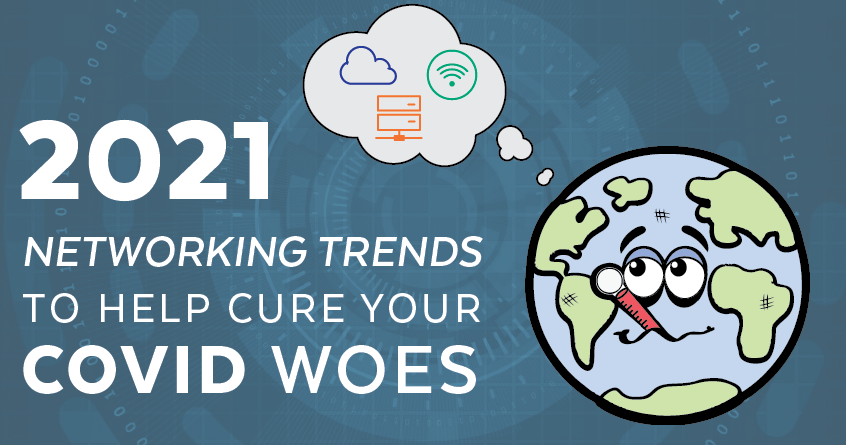COVID-19 has changed not only our private lives but our work lives forever. All types of industries—retail, medical, hospitality, technology—have been upended because of this global crisis.
The word for the future is resiliency.
The new normal will be rife with strategies and technologies designed to support businesses to stay ahead of the next big “thing.”
Power over Ethernet (PoE) continues its steady trajectory into the 90W delivery range with all of the exciting IoT and IIoT device development. On the horizon we also see a streamlining opportunity with the advances in single-pair Ethernet development. This article discusses some of the other significant business networking trends for the new year—2021.
Networking Trend 1: Continued Teleworking
As the world begins to recover from the coronavirus pandemic, many workers will be able to return to their workplace. However, this appears to be one of the networking trends that will likely continue. According to workspace designing company, Fentress Incorporated:
The COVID-19 pandemic has forced workers out of the office and has led to a massive rise in telework. Many experts predict that telework will become the new normal. One thing’s for sure – telework to some degree is here to stay.
Teleworking has some inherent challenges that must be addressed—things like reliable and secure connectivity that supports high-bandwidth applications such as videoconferencing.
Networking Trend 2: Working in the Cloud
The Cloud will continue to help companies save both space and money. Businesses of all types and sizes will continue to adopt Cloud services. The benefits of the Cloud are numerous and include:
- Cost Reduction
- Efficiency
- Data Security
- Scalability
- Mobility
- Disaster Recovery
- Control
SD-WAN
The use of a software-defined wide-area network (SD-WAN) technology will increase in 2021. Two of SD-WAN’s primary features are (1) managing multiple connections from multi-protocol label switching (MPLS) to broadband to long term evolution (LTE) and (2) the ability to segment, partition, and secure traffic crossing the WAN.
According to the technology conglomerate, Cisco:
SD-WAN is a software-defined approach to managing the WAN. Key advantages include:
- Reducing costs with transport independence across MPLS, 4G/5G LTE, and other connection types.
- Improving application performance and increasing agility.
- Optimizing user experience and efficiency for software-as-a-service (SaaS) and public-cloud applications.
- Simplifying operations with automation and cloud-based management.
SASE Technology
As the SD-WAN market matures, vendors are tying it more closely to security. Secure access service edge (SASE-pronounce “sassy”) is a network architecture that combines SD-WAN with security. According to Orange S.A, a global integrator of business services:
…SASE is the convergence of network and network security services that have previously been delivered through separate physical appliances into an integrated cloud-native service. SASE promises to deliver comprehensive and holistic network security services to support the needs of business and empower digital business transformation. It will increase the adoption of cloud-native services and edge computing platforms and enable enterprises to deliver IT services at high speed with strongly secured access and reduced costs.
The main benefits of SASE are:
- Enhanced network performance
- Better user experience (UX)
- Reduced costs
Networking Trend 3: Wi-Fi 6
In 2021, the use of Wi-Fi 6 (IEEE 802.11ax) will have widespread growth. However, there is a nearly insatiable demand for more Wi-Fi speed, reliability, and efficiency. Over the next ten years, Wi-Fi will face challenges such as increased traffic congestion, dissatisfaction with performance limitations, and a reduction in quality of service (QoS).
A white paper by ABI research states:
As a result of this traffic explosion, cellular operations are increasingly looking to offload traffic onto Wi-Fi. Similarly, consumers with limited data plans are deciding to connect to Wi-Fi when at home or in public areas to circumvent these limitations. In order to do so, however, the user experience must be comparable to that of the existing cellular network, and the Wi-Fi network must be able to accommodate this extra traffic. Cisco anticipates that mobile offload is set to increase from 60% (10.7 exabytes/month) to 63% (83.6 exabytes/month) by 2021, with 64% of traffic from smartphones and 72% from tablets forecasted to be offloaded onto Wi-Fi by 2021, placing additional burdens on the 5 GHz band.
Networking Trend 4: 5G
The latest standard for global wireless networks is 5G. This technology is comparable to Wi-Fi 6 but usually works on a far larger scale. For example, Wi-Fi is typically used in an office, store, or restaurant, whereas 5G is used in outdoor settings or large-scale businesses. Although 5G is still in its infancy, the 5G boon is on! 2021 will be the year the first real-life 5G uses cases will go into production, and more 5G-capable devices hit the marketplace.
According to CB Insights:
Demand for 5G is expected to be intense, and dozens of corporations are seizing the opportunity. Companies are vying to take 5G lead range from network provider Verizon to device maker Samsung to chipset maker Qualcomm, among many others.
And before widespread 5G network connectivity is possible, telecommunications companies will have to invest in significant network upgrades, including installing equipment for new spectrum bandwidths, laying fiber optics, and the development of cellular transmission technology.
In 2020, more businesses employed cellular connectivity than ever before. With an abundance of new use cases popping up due to COVID-19, enterprises will tap into 5G to help more users get more work done faster, even in hard-to-reach areas.
Networking Trend 5: IoT/Edge Networking
If there is one positive thing about COVID-19, it may be this: the pandemic has forced organizations to get ultra-creative in how they reach end-users and support employees in numerous places. For example, business owners that devised pop-up outdoor points of sale to enable curbside ordering and pickup and medical facilities equipped their parking lots with wireless solutions to triage new patients and administer COVID-19 testing.
According to Hewlett Packard:
Edge computing is a distributed, op IT architecture that features decentralized processing power, enabling mobile computing and Internet of Things (IoT) technologies. In edge computing, data is processed by the device itself or by a local computer or server, rather than being transmitted to a data center.
The way data is processed and delivered is being transformed by edge computing. The growth of internet-connected devices and new applications that require real-time computing power has been explosive. COVID-19 has accelerated this edge computing trend, which will continue in 2021.
Forester makes the following prediction for edge computing for 2021:
New edge vendors will shave five points off public cloud growth. Cloud services continue to grow like weeds. The pandemic pushed cloud revenues higher than expected in 2020. That bull run will continue into 2021, but we will see edge computing moderate that meteoric growth a bit. As edge computing becomes a “cool” new platform for business computing, it will siphon some of the money that would otherwise have gone to cloud expansion.
Networking Trends: Conclusion
2021 will be a year of resiliency and growth. The networking arena will thrive with trends such as teleworking tools, the Cloud, Wi-Fi 6, 5G, and the edge—and especially with the long-awaited COVID-19 vaccine.
Find out more about PLANET IT Networking devices.
